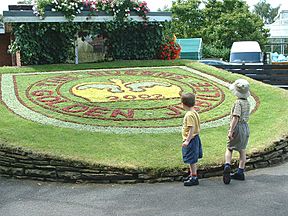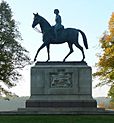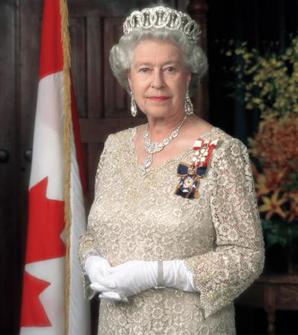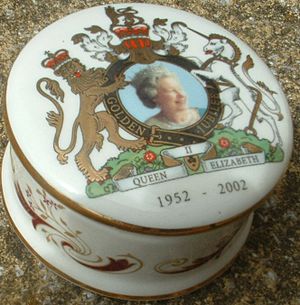Golden Jubilee of Elizabeth II facts for kids
Quick facts for kids Golden Jubilee of Elizabeth II |
|
|---|---|
|
Collage of commemorations of the jubilee, Clockwise: The London Eye illuminated in gold; Concorde parade flight with the Red Arrows; Flower arrangement in Stafford; Routemaster in Golden Jubilee livery; Equestrian statue of the Queen erected in Windsor Park; Union Street in Aberdeen with Golden Jubilee bunting
|
|
| Genre | Jubilee of British monarch |
| Date(s) | 6 February 2002 |
| Country | |
| Previous event | Ruby Jubilee of Elizabeth II |
| Next event | Diamond Jubilee of Elizabeth II |
The Golden Jubilee of Elizabeth II was a big worldwide party in 2002. It celebrated Queen Elizabeth II being Queen for 50 years. She became Queen of the United Kingdom and other Commonwealth countries on February 6, 1952. The Queen wanted it to be a way to remember her 50 years as ruler. It was also a chance for her to thank her people for their support.
Sadly, the Queen's sister, Princess Margaret, and her mother, Queen Elizabeth The Queen Mother, passed away early in 2002. Some people thought the celebrations might not happen. But the Jubilee went ahead with huge events in London in June. Other events took place across the Commonwealth realms. Queen Elizabeth and her husband, Prince Philip, Duke of Edinburgh, attended all planned events. They traveled over 40,000 miles (64,000 km) that year. They visited the Caribbean, Australia, New Zealand, and Canada. They also toured around the United Kingdom. Many places like landmarks and parks were named after the Jubilee. Special medals and stamps were also made.
The Golden Jubilee had six main ideas: 'Celebration', 'Giving Thanks', 'Service', 'Involving the Whole Community', 'Looking Forward as Well as Back', and 'Commonwealth'.
Contents
- Golden Jubilee Celebrations Around the World
- Jubilee Celebrations Outside the Commonwealth
- Monuments and Souvenirs
- See also
Golden Jubilee Celebrations Around the World
The Golden Jubilee was celebrated in many countries. These countries are part of the Commonwealth of Nations. The Queen is the head of the Commonwealth.
Australia's Jubilee Events
As Queen of Australia, under your constitution, and as Head of the Commonwealth, I look forward to the coming few days here. I look around tonight and I am aware both of my responsibilities, and of the pleasure those responsibilities bring. And in this Golden Jubilee year, I cannot but reflect on the extraordinary opportunity I have been given to serve the people of this great country. The way Australia evolves over the next fifty years is in your hands.
The Royal Australian Mint made special coins for the Queen's Golden Jubilee. Queen Elizabeth II visited Australia to mark her 50 years as Queen of Australia. On February 27, she arrived in Adelaide. The Governor-General, Peter Hollingworth, welcomed her.
On the Queen's Birthday holiday in 2002, churches held special services. A bonfire was lit at the Governor-General's home in Canberra. This was part of a big party.
Canada's Golden Jubilee
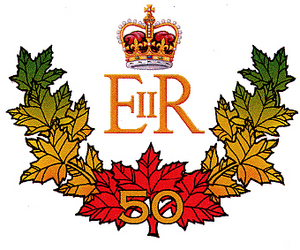
All across Canada, events took place throughout the year. These events celebrated the Golden Jubilee. For example, the Lieutenant Governor of Alberta, Lois Hole, held a special event. More than 4,000 people attended. She said the monarchy is very important to Canada.
Queen Elizabeth's Canadian Tour
Her Majesty The Queen of Canada has been unfalteringly by our side to celebrate our successes and to help us to grow together. Fifty years after her Accession to the Throne, Elizabeth II remains a symbol of continuity, stability and tradition in a world that is under a barrage of constant change. That is why Canadians are proud to celebrate the Golden Jubilee.
In October 2002, the Queen and Prince Philip toured Canada for 12 days. They visited many cities. These included Victoria, Vancouver, Winnipeg, and Toronto. They also went to Ottawa, the capital city.
- Nunavut
This trip was special because it was the first royal visit to Nunavut. Nunavut is Canada's newest territory. On October 4, the Queen opened the new legislative assembly in Iqaluit. She said she was proud to be the first royal to visit the new territory. She also unveiled a street sign. The main street in Iqaluit was renamed in her honor.
- British Columbia
From Nunavut, the royal couple flew to Victoria. The Lieutenant Governor of British Columbia welcomed them. On Sunday, the Queen went to church. She also visited the British Columbia Parliament Buildings. There, she unveiled a stained glass window. This window honored the Golden Jubilee. The Snowbirds, a famous air show team, flew over for the Queen. About 16,000 people watched.
In Vancouver, on October 6, the Queen did something unique. She dropped the ceremonial first puck at a National Hockey League game. This was the first time a reigning monarch had done this. She watched the first part of the game. The Premier of British Columbia, Gordon Campbell, spoke during the visit. He said the people of British Columbia had a deep affection for their Queen.
- Saskatchewan

Next, the Queen and Prince Philip visited Saskatchewan. They unveiled a bronze equestrian statue of the Queen. It showed her riding Burmese, a horse given to her by the RCMP. In Winnipeg, Manitoba, the Queen walked around The Forks. She also re-dedicated the Golden Boy statue. This statue sits atop the Manitoba Legislative Building. She also attended a ballet performance.
- Ontario
On October 9, thousands of people welcomed the Queen to Ontario. That evening, she attended a festival at Exhibition Place. It showed how the province had grown over 50 years. The Queen visited Sheridan College. She saw students learning computer animation. In Hamilton, she presented new Colours to a military group. She also visited the Canadian Broadcasting Corporation. There, she saw old videos of her past tours in Canada. Finally, she attended a concert with Canadian artists. A park near Gravenhurst was renamed the Queen Elizabeth II Wildlands Provincial Park. An award for civilian bravery was also created.
- New Brunswick
The royal tour continued to the maritime provinces. They arrived in Fredericton, New Brunswick. Thousands of people welcomed them. This stop was short, only 25 hours. The Queen and Duke flew to Sussex and then to Moncton. They attended a lunch in Dieppe. This celebrated the town's 50th anniversary. They also opened a new terminal at Greater Moncton International Airport.
- Ottawa
From the east coast, the royal couple flew back to Ottawa. They were greeted by the Deputy Prime Minister of Canada, John Manley. On October 13, a multi-faith Thanksgiving celebration was held on Parliament Hill. About 3,500 people attended. The Queen laid a wreath at the Canadian Tomb of the Unknown Soldier. That evening, a dinner was held at the Canadian Museum of History. The Queen thanked all Canadians for their loyalty and support. As her car passed into Quebec, about 100 protesters shouted in French. They waved Quebec flags. This was the only protest during the tour.
On the last full day, the Queen watched the Royal Canadian Mounted Police's Musical Ride. She then had lunch at Rideau Hall with fifty important Canadians. She also planted a tree at her Canadian home. The Queen and Prince Philip left Canada on October 15.
Canada's Jubilee Impact
Many people felt the Jubilee helped both Canadian identity and the monarchy. The Globe and Mail newspaper said the Queen dropping the puck at a hockey game was a brilliant moment. It showed a mix of Canadian and royal symbols.
Jamaica's Jubilee Celebrations
Prince Philip and I have a unique opportunity to see and hear about these ways in which you are meeting the challenge of giving every Jamaican a stake in the future during our short visit in this year which marks both Jamaica's fortieth anniversary of Independence and my Golden Jubilee. Such anniversaries are important.
The Queen's first official Jubilee events were in Jamaica. Her visit also happened during Jamaica's 40th anniversary of independence. She arrived on February 18, 2002. This was nine days after her sister, Princess Margaret, Countess of Snowdon, passed away. The Queen observed a short period of private mourning. She was first welcomed in Montego Bay. Then she traveled to Kingston. She stayed at the Jamaican prime minister's home.
Even though some people in Jamaica were against the monarchy, the Queen and Prince Philip were "enthusiastically welcomed." Most people thought the visit was important. Large crowds came to see the Queen. There were small protests by Rastafarians. They were asking for money for slavery and to return to Africa. The Queen was officially welcomed at King's House. This is the Governor-General's home. She met with Jamaican veterans of the First World War. She also spoke to her Jamaican parliament. She visited a poor area of Kingston called Trenchtown. She saw projects helping urban poverty. The tour ended in a memorable way. During a dinner, the power went out at King's House.
New Zealand's Jubilee Events
Jubilee Commemorations
Many events marked the Queen's Golden Jubilee in New Zealand. They also remembered her first visit to New Zealand in 1953-54. Prime Minister Helen Clark said, "Queen Elizabeth II has been Queen of New Zealand for fifty years and is held in warm regard by New Zealanders. It is fitting that we honour her."
NZ Post released special stamps for the Jubilee and Royal Visit. The Reserve Bank issued a special coin in October 2001. The Queen's Birthday and Golden Jubilee Honours were announced on June 3. A special church service was held on June 7 in Wellington. The Governor-General and government officials attended.
Parliament's Visitor Centre showed items from past royal visits. The Ministry for Culture and Heritage had an online exhibit about the 1953-54 visit. New Zealanders were asked to share their memories of royal visits. The national museum, Te Papa, also had a big exhibit about the 1953-54 royal visit.
Royal Tour of New Zealand
It is both a privilege and a pleasure to have served as Queen of New Zealand for these fifty years. I thank you all for the loyalty and support you have given to me throughout this time.
After her trip to Jamaica, the Queen visited New Zealand. She stopped in Auckland, Taupo, Christchurch, and Wellington. She and Prince Philip arrived on February 22. Just before her arrival, Prime Minister Helen Clark said New Zealand would likely become a republic. The Governor-General and other officials greeted the royal couple. Prime Minister Clark was away at a meeting. Not many people came to see the Queen at the airport. However, about 4,000 people came to see her in Auckland. During the tour, the Queen met Georgina Beyer, the world's first transsexual MP.
The government and people of New Zealand gave the Queen a gift. It was the Dictionary of New Zealand Biography and the New Zealand Historical Atlas.
United Kingdom's Jubilee Celebrations
This anniversary is for us an occasion to acknowledge with gratitude the loyalty and support which we have received from so many people since I came to the Throne in 1952. It is especially an opportunity to thank all those of you who help others in your own local communities through public or voluntary service. I would like to think that your work will be particularly recognised during this Jubilee year. I hope also that this time of celebration in the United Kingdom and across the Commonwealth will not simply be an occasion to be nostalgic about the past. I believe that, young or old, we have as much to look forward to with confidence and hope as we have to look back on with pride.
Celebrations for Queen Elizabeth II's Golden Jubilee happened across the United Kingdom. They took place between May and July 2002. Before the events, some media outlets thought the Jubilee would not be popular. They felt people were no longer interested in the monarchy. But these predictions were wrong. Hundreds of thousands of people came out for the celebrations. The biggest event was on June 4 on The Mall in London. Over one million people watched the parade and flypast.
On March 3, the Queen and Prince Philip returned to London from Australia. On March 11, Commonwealth Day, a new portrait of Elizabeth was shown. It was painted to mark her 50 years as Head of the Commonwealth. At the end of March, the Queen faced another sadness. Her mother passed away on March 30. The Commonwealth countries observed a period of mourning. On April 9, the day of her mother's funeral, over one million people gathered. They were outside Westminster Abbey and along the route to Windsor Castle.
Plans for the Golden Jubilee in the UK continued. The Queen had a dinner with her former British Prime Ministers. Then, on April 30, she officially started the UK celebrations. She gave a speech to both houses of the British parliament at Westminster Hall. This was the fifth time she had spoken to her British parliament about her reign. The Queen talked about 50 unforgettable years. She spoke about changes in British life. She said the monarchy must also change. Elizabeth declared her wish to keep serving the people.
Many other events were organized for the Jubilee. The British Army held a special parade in Portsmouth. It included 6,000 people from all parts of the British Armed Forces. The Queen's bodyguards also had a combined parade. Three hundred members of different guard groups marched together for the first time. Elizabeth also hosted a dinner for all of Europe's kings and queens. She held another dinner for all her Governors-General. Garden parties were held at Buckingham Palace and Holyrood Palace. These were for people born on Accession Day 1952. Around the country, people organized street parties. About 40,000 toolkits were given out to help with these parties.
A Golden Jubilee Poetry competition was held for children. Children aged 7 to 18 could submit poems. They wrote about how the UK changed in 50 years. The winner received a special medal from the Queen. All poems were kept in the Royal Archives at Windsor Castle.
Goodwill Visits Across the UK
The Queen's goodwill visits started on May 1. She spent two to three days in different parts of England. First, she visited Cornwall, Devon, and Somerset. Then she went to Tyne and Wear. Finally, she visited Buckinghamshire and Berkshire. On May 13, the Queen and Prince Philip visited Northern Ireland. They went to places like County Fermanagh and Omagh. In mid-May, the royal couple spent time in London. They promoted the arts. They attended the Chelsea Flower Show. They also dedicated the Queen's Gallery at Buckingham Palace.
The Jubilee trips started again on May 23. This was a six-day trip to Scotland. The royals visited Glasgow, Edinburgh, and Aberdeen. After the Jubilee weekend in London, the Queen and Prince Philip toured West Sussex on June 7. They spent three days in Wales. They visited Anglesey, Llanelli, and Cardiff. The next month, they made two-day trips to the West Midlands and Yorkshire. In Yorkshire, the Queen visited the set of the TV show Emmerdale. They also visited Suffolk and Norfolk. They had a three-day trip to Liverpool and Manchester. In Manchester, the Queen opened the 2002 Commonwealth Games. The Queen finished July by touring the East Midlands. She ended her UK tour by visiting Lancashire.
Golden Jubilee Weekend in London

The Golden Jubilee Weekend was from June 1 to 4, 2002, in London. The Queen and Prince Philip arrived from Scotland on May 29. On Saturday evening, the Prom at the Palace took place. It was in the gardens of Buckingham Palace. This event featured classical music. Out of two million people who wanted tickets, 12,500 were chosen. This was the largest event ever held on the royal property. The BBC Symphony Orchestra and Chorus entertained the crowds. Famous singers also performed.
The next day, the Queen and her husband attended a church service. It was at St. George's Chapel, Windsor Castle. Other members of the Royal Family attended services elsewhere. The Prince of Wales and his sons, Princes William and Harry, were in Swansea.
On June 3, Queen Elizabeth II and Prince Philip returned to London. At 1:00 pm, the Queen launched the nationwide BBC Music Live Festival. Over 200 towns and cities played the Beatles song "All You Need Is Love" publicly. Street parties were held across the country that day. That evening, the Queen, Prince Philip, and other royals attended another concert. It was on the grounds of Buckingham Palace. This concert, called Party at the Palace, showed pop music from the last 50 years. Famous acts like Paul McCartney and Eric Clapton performed. Queen guitarist Brian May started the event. He played "God Save the Queen" from the palace roof. Paul McCartney ended the night with songs like "Hey Jude". After the concert, the Queen lit the National Beacon at the Victoria Memorial. This was the last of 2,006 beacons lit worldwide. This echoed Queen Victoria's Golden Jubilee in 1887. 12,000 guests were at the concert. Another one million people gathered on The Mall. They watched on giant screens and sang along. 200 million people watched the event on TV around the world.
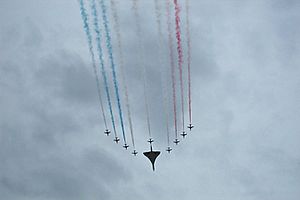
On June 4, the entire royal family attended a special church service. It was at St Paul's Cathedral. The Queen rode in the Gold State Coach. After the service, they had lunch at the Guildhall. The Queen spoke there. She said she was proud of the Commonwealth's achievements. She said, "Gratitude, respect and pride, these words sum up how I feel about the people of this country and the Commonwealth—and what this Golden Jubilee means to me."
The Jubilee procession then started along The Mall. Entertainers performed for the Queen. Many floats showed British life during Elizabeth's reign. The parade ended with 5,000 adults and children from the 54 Commonwealth countries. They marched in their national costumes. They presented the Queen with "a rainbow of wishes." These were handwritten notes from children across the Commonwealth. Over one million people watched. The Royal Family gathered on the balcony of Buckingham Palace. They watched a flypast. It included every type of Royal Air Force aircraft (27 in total). Concorde and the Red Arrows also flew by. There was only one small negative event. About 40 activists were arrested during a protest before the Jubilee Weekend.
Turks and Caicos Islands Jubilee
In the Turks and Caicos Islands, a British Overseas Territory, celebrations happened from June 1 to 4. The Governor, Mervyn Jones, led the events. A special Jubilee Souvenir Brochure was made. It had historical photos of royal visits. Only 5,000 were printed. Queen Elizabeth II received issue number 1. The museum also provided photos for three sets of stamps. For the Jubilee Weekend, the museum had an exhibit on royal visits. Other items made for the Jubilee included a straw crown. Two special 20-crown coins were also made. All school children received a badge to remember the event.
Jubilee Celebrations Outside the Commonwealth
The Golden Jubilee was also celebrated in New York City. The top of the Empire State Building was lit in royal purple and gold. The city's mayor, Michael Bloomberg, said it was a thank you to the Queen. She had played the American national anthem at Buckingham Palace after 9/11. It was also a thank you to the British people for their support. It had been over 10 years since the Empire State Building honored someone not from the United States. The last time was for Nelson Mandela in 1990.
Monuments and Souvenirs

Before, during, and after the Jubilee year, many souvenirs were made. Monuments were unveiled, and public places were named. In Australia, Australia Post released a special stamp. It combined old and new images of Queen Elizabeth II. A booklet about her reign was also released.
In Canada, the government gave $250,000. This was a donation in the Queen's name to the Dominion Institute's Memory Project. This project teaches young Canadians about veterans. The provinces also marked the milestone. In Ontario, a park was renamed the Queen Elizabeth II Wildlands Provincial Park. In Saskatchewan, an equestrian statue of Queen Elizabeth II was put up. It stands near the Queen Elizabeth II Gardens. In Alberta, a law created new awards. These included the Queen's Golden Jubilee Citizenship Medal.
In the United Kingdom, a special £5 coin was released. The annual Queen's Golden Jubilee Award for volunteer groups started in 2002. Companies like Spode made commemorative china and crystalware. At Windsor Castle, the Jubilee Gardens were opened. This was the first new public area there since 1820. A roller coaster called Jubilee Odyssey was built at Fantasy Island theme park.
Cedars Park in Cheshunt, Hertfordshire, got a new entrance gate. It was built to honor the Jubilee. The park is historic because it was once the site of Theobalds Palace.
See also
 In Spanish: Jubileo de Oro de Isabel II para niños
In Spanish: Jubileo de Oro de Isabel II para niños





